2012 AMA Flat Track Season Finale - Video
Regular MO readers recognize that we generally pay more attention to circuit racing on pavement than competition in the dirt. However, we’re not stupid enough to think dirt-centric competition is dull.
Americans have been racing motorcycles around oval fairground dirt tracks almost as long as there have been motorcycles. It continues to this day barely changed from its dusty past. Meanwhile, circuit racing on asphalt tracks gets most of the contemporary glory with race fans.
To reintroduce ourselves with good ol’ dirt-track action, we headed to the AMA Pro Grand National Championship season finale at the L.A. County Fairplex in Pomona, California. Not unexpectedly, the on-track action on the half-mile “cushion” track (where dirt builds up on the outside of the corners) was intense, with blazing corner-entrance speeds that looked like sure crashes in the making but almost never were.
“I had no idea they would be hitting the speeds that they did, and the first thing that I thought about was how much it was like the motorcycle version of a rallycross,” raved our photo/video expert Mike Maez after his first taste of dirt-tracking.
Adding to the intrigue of the featured Expert Twins class is participation from no less than seven different brands of motorcycles. Harley-Davidsons still dominate the grid, but it’s refreshing to see the diversity of several Kawasakis and Suzukis, plus a Ducati, a BMW/Rotax and a Triumph added to the show.
Championships On The Line
Three riders were in the hunt for the AMA Pro Harley-Davidson Insurance Grand National Championship title heading into the season finale at Pomona. Harley-mounted Jared Mees came into Pomona with a 12-point advantage over Sammy Halbert on another H-D XR750. Mees has collected nine podium finishes this season but only one win. Halbert had logged four victories in 2012, the most of any rider in the class, but hasn’t been as consistent as Mees.
Sitting 20 points back is two-time reigning champ Jake Johnson on another Harley. Johnson, victor last year at Pomona, is the only rider to score a win in every season over the last decade. But despite eight podium finishes this year, he had yet to score a win.
Bryan Smith spices up the Harley train with his Howerton Racing Kawasaki, sitting fourth in points coming into Pomona. His flat-tracker uses a modified and enlarged Ninja 650 engine that has powered him to victories this season at the high-speed Sacramento and Springfield Miles. Pomona would be his first time riding the Kawi at a half-mile track. Smith joined three other Kawasaki riders in qualifying for the Main event at Pomona, including roadracer JD Beach.
Brad Baker came into Pomona fifth in points. The Washington native rode a Lloyd Brothers Ducati to second place last year, but he’s riding an XR750 Harley in 2012. Interestingly, Scott Baker, Brad’s little brother, qualified for the Main at Pomona on a BMW F800-based machine.
Henry Wiles, sixth in the points battle, adds another dimension to the Grand National class by riding a Ducati-based dirt-tracker. The Michigan rider has been unbeatable on TT tracks (raced with motocross-based machines on tracks with right turns and a jump) this season, with wins at both Springfield and Peoria, plus a victory at the short track in Springfield.
Also worthy of our attention is Kenny Coolbeth, Jr., an XR750-mounted rider who missed several races this season due to injury. But Coolbeth won last month at a half-mile track and is normally a regular front-runner in the series.
Triumph Returns to the Dirt!Triumph has had heaps of success racing on the dirt tracks of America, but the historic British firm took a 30-year hiatus until Bonneville Performance, a Florida-based flat-track team, began racing a Triumph back in 2005.
“We were a family Triumph-powered team in the ’70s and it was a major blow to see the brand that once dominated virtually disappear,” team principal Bill Gately told us. “It has been my dream for my second career to bring the brand back to Grand National Flat-Track Racing.”
Gately took on the challenge of creating a competitive racer built around Triumph’s parallel-Twin and takes advantage of the 1000cc limit for air-cooled production Twins with a 995cc motor. Gately uses the 270-degree crank used in Triumph’s cruiser models that mimics a V-Twin’s power pulses rather than the Bonneville’s 360-degree crank.
The team’s 2012 season began on a downer when former Grand National Pro Sport Champion Mikey Martin was badly injured in a crash while running second in the season-opening Springfield TT and took nearly half the season to fully recover. And, as might be expected from a team developing a new platform, results have been inconsistent. The diminutive 19-year-old Martin has qualified for five Main events this season and scored a best of ninth place while competing at the Sacramento Mile.
“We have had an up-and-down season,” Gately admitted. “Our second half has been amazing. Mikey has made great strides in his rookie season. “
Despite top speeds nearly 5 mph faster than the rest of the field (107 mph, according to the team’s radar gun) Martin unfortunately and narrowly missed out qualifying for the Main event at the Fairplex round. The Trumpet had a difficult time hooking up with the track’s paperclip-like configuration.
“Pomona was a struggle for us,” Gately told us afterward. “It’s an extremely technical track that gave some of the best an extremely tough day.
“We have great expectations for the 2013 season and are extremely proud to carry the Triumph brand next season,” Gately added. “I only wish my dad, granddad and my uncle were still here to live it with us.”
The Scene
Shooter Maez and I arrived at the Fairplex while teams were loading in their equipment. Appropriate for a dirt-track event, the paddock area is unpaved. Its small size forced teams to set up in areas no bigger than two Easy-Up canopies, a far cry from the semi-trailer-sized pits we see in roadracing.
“My first impression was that the entire event had a grassroots feel to it,” Maez remarked. “The pits felt more like the race group of a club-racing day at a local track than the championship round of a pro racing series. All of the riders and teams were accessible in the pits, with no fancy trailers and nothing but real enthusiasm for the sport on display.”
And if you doubt the appeal of dirt-track racing, consider some of the motorcycle celebrities we spotted at Pomona. Dirt-track legend Eddie Mulder was somewhat expected, but we were pleasantly surprised to see a couple of roadracing stars spectating. John Kocinski, a champion in World Superbike and 250cc Grand Prix, showed up. He still races dirt-track at local California events and looked admiringly at the Bonneville Performance Street Tracker as I rode it out of the track early in the day. In addition, recently crowned three-time AMA Superbike champ Josh Hayes brought his roadracing wife, Melisa Paris, to the races.
Practice sessions took place late in the afternoon, followed by the qualifying segments that determine where the 30 riders in attendance would line up in the three heat races that began in the evening.
It’s an amazing show, as time gaps between riders are incredibly tight, quite frequently much less than a tenth of a second and often by less than a hundredth of a second. And the speeds at which racers enter the corners are difficult for a brain to comprehend.
“As the racing grew near and the stands began to fill, I really felt the tension build up,” commented Maez before the Heat races began. “And as opening ceremonies drew to a close, I was excited to see what kind of action was in store.”
Most of the usual suspects made it through to the Main via their heat races. In Heat 1, Brad Baker took the win ahead of Jethro Halbert and points leader Mees, with Wiles in fourth on the Ducati. Bryan Smith finished the heat in seventh despite running the third-best lap time and was relegated to contending semi-final race 1.
Steve Bonsey, another rider with roadracing background, took the Heat 2 win ahead of Robert Pearson on another XR750 Harley, followed by Briar Bauman on a Suzuki-powered machine and Brandon Robinson on an additional Kawasaki, this one tuned by Hall-of-Fame tuner Bill Werner.
Heat 3 saw Coolbeth rocket to victory with a substantial gap back to runner-up Sammy Halbert. JD Beach was less than one second behind on his Kawasaki, followed by Jeffrey Carver Jr.
In the Semis, Bryan Smith took an easy win in the first one, while Johnson redeemed himself with victory in the second.
The Main Event
“When the green flag dropped and the riders flew sideways into the first turn, I was shocked at both the entry speeds and the bar-to-bar proximity of the entire field,” remarked an obviously impressed Maez about the spectacle of flat-track racing.
Action during the first few laps was so furious and so tight that it was difficult to keep track of just exactly who was banging handlebars with whom. Eventually the field began to sort itself out, and running up front was Kenny Coolbeth.
The Connecticut rider was in a different league than the others on this night, and it was quite a sight to see the brake rotor on his rear wheel glowing red as he entered the corners following each straightaway. His brake was the only one to do that, indicating less material in his rotor than the others. Coolbeth cruised to victory at Pomona with nearly a 10-second cushion on his rivals.
“This win is a great way to go into the off-season,” said Coolbeth about his dominating performance following a broken leg suffered mid-season. “We had my injury and then we won a race but didn’t run well after that. Now we can go through the winter knowing we can win and be a force next season.”
The battle for second place was much more intense. Heat-1 winner Brad Baker was trying vainly to keep pace with Coolbeth, while Bryan Smith was hustling his Kawasaki through the field from his 14th-place starting position. Smith caught up with Baker, and the two battled bar to bar for the runner-up spot. Baker was able to hold off the Kawi rider at the line by just 0.145 second.
Meanwhile, the battle for the championship was surprisingly not up front. Points leader Mees was struggling mid-field, but his title rival, Sammy Halbert, was performing even worse. Halbert suffered clutch problems and ended up outside the top 10 in 13th place. Fellow title contender Jake Johnson was also unable to challenge Mees, finishing about a second behind Halbert.
So Mees rode smartly to end up in eighth place behind the Ducati-mounted Henry Wiles. It was good enough to earn Mees the coveted AMA Pro Grand National Championship and the $20,000 check from Harley-Davidson Insurance that goes with it.
“I kind of knew where I was at the whole way and was able to bring it home,” said Mees after the race. “The feeling hasn't really sunk in yet. So much hard work and dedication has gone in to this season and it all paid off.”
While the Fairplex grandstands were mostly packed for the races, we wondered why – in the motorcycle hotbed of Southern California – they weren’t jammed to the rafters with motorcycle enthusiasts. The fantastic action on track is so visually arresting that it’s entertaining even for non-enthusiasts, as my wife and 5-year-old daughter can attest.
“All of the sideways action combined with the tight proximity of the riders made for an exhilarating spectacle,” said Maez. “And I could only imagine the adrenaline rush of being a rider!”
The flat-track action was so good, we’ll definitely be back.
Related Reading
Motorcycle Beginner - Year 2: Up Close with Canadian Superbike Racing
2012 Pikes Peak International Hill Climb Report
MotoGP 2012 at Laguna Seca
Speedway Grand Prix in America
Infineon Raceway West Coast Moto Jam Report
2011 Red Bull U.S. Grand Prix Event Report - Video
More by Kevin Duke



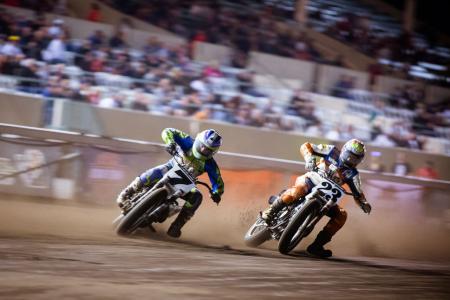




















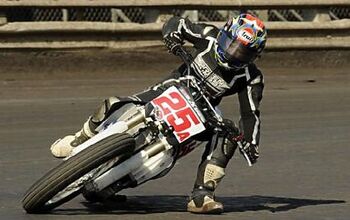
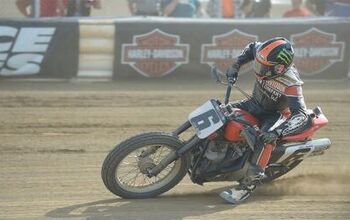
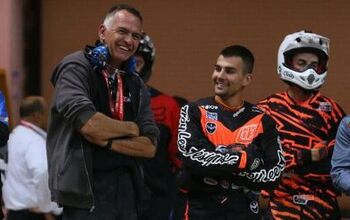

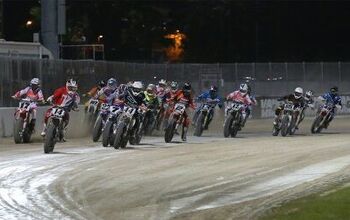













Comments
Join the conversation